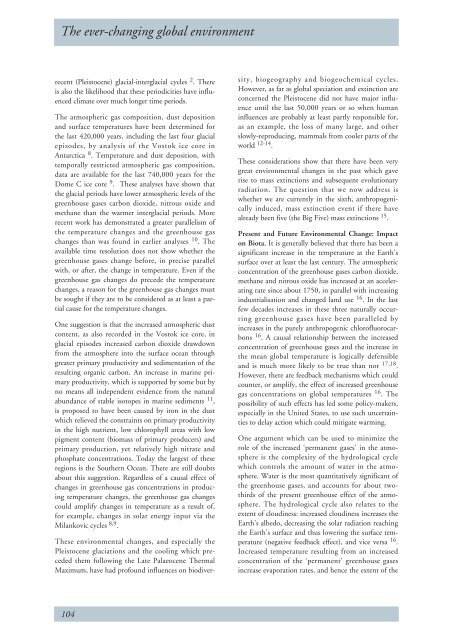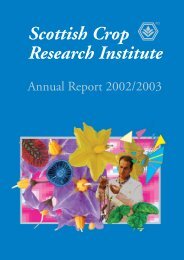SCRI Annual Report 2003/2004 - Scottish Crop Research Institute
SCRI Annual Report 2003/2004 - Scottish Crop Research Institute
SCRI Annual Report 2003/2004 - Scottish Crop Research Institute
Create successful ePaper yourself
Turn your PDF publications into a flip-book with our unique Google optimized e-Paper software.
The ever-changing global environment<br />
recent (Pleistocene) glacial-interglacial cycles 2 . There<br />
is also the likelihood that these periodicities have influenced<br />
climate over much longer time periods.<br />
The atmospheric gas composition, dust deposition<br />
and surface temperatures have been determined for<br />
the last 420,000 years, including the last four glacial<br />
episodes, by analysis of the Vostok ice core in<br />
Antarctica 8 . Temperature and dust deposition, with<br />
temporally restricted atmospheric gas composition,<br />
data are available for the last 740,000 years for the<br />
Dome C ice core 9 . These analyses have shown that<br />
the glacial periods have lower atmospheric levels of the<br />
greenhouse gases carbon dioxide, nitrous oxide and<br />
methane than the warmer interglacial periods. More<br />
recent work has demonstrated a greater parallelism of<br />
the temperature changes and the greenhouse gas<br />
changes than was found in earlier analyses 10 . The<br />
available time resolution does not show whether the<br />
greenhouse gases change before, in precise parallel<br />
with, or after, the change in temperature. Even if the<br />
greenhouse gas changes do precede the temperature<br />
changes, a reason for the greenhouse gas changes must<br />
be sought if they are to be considered as at least a partial<br />
cause for the temperature changes.<br />
One suggestion is that the increased atmospheric dust<br />
content, as also recorded in the Vostok ice core, in<br />
glacial episodes increased carbon dioxide drawdown<br />
from the atmosphere into the surface ocean through<br />
greater primary productivity and sedimentation of the<br />
resulting organic carbon. An increase in marine primary<br />
productivity, which is supported by some but by<br />
no means all independent evidence from the natural<br />
abundance of stable isotopes in marine sediments 11 ,<br />
is proposed to have been caused by iron in the dust<br />
which relieved the constraints on primary productivity<br />
in the high nutrient, low chlorophyll areas with low<br />
pigment content (biomass of primary producers) and<br />
primary production, yet relatively high nitrate and<br />
phosphate concentrations. Today the largest of these<br />
regions is the Southern Ocean. There are still doubts<br />
about this suggestion. Regardless of a causal effect of<br />
changes in greenhouse gas concentrations in producing<br />
temperature changes, the greenhouse gas changes<br />
could amplify changes in temperature as a result of,<br />
for example, changes in solar energy input via the<br />
Milankovic cycles 8,9 .<br />
These environmental changes, and especially the<br />
Pleistocene glaciations and the cooling which preceded<br />
them following the Late Palaeocene Thermal<br />
Maximum, have had profound influences on biodiversity,<br />
biogeography and biogeochemical cycles.<br />
However, as far as global speciation and extinction are<br />
concerned the Pleistocene did not have major influence<br />
until the last 50,000 years or so when human<br />
influences are probably at least partly responsible for,<br />
as an example, the loss of many large, and other<br />
slowly-reproducing, mammals from cooler parts of the<br />
world 12-14 .<br />
These considerations show that there have been very<br />
great environmental changes in the past which gave<br />
rise to mass extinctions and subsequent evolutionary<br />
radiation. The question that we now address is<br />
whether we are currently in the sixth, anthropogenically<br />
induced, mass extinction event if there have<br />
already been five (the Big Five) mass extinctions 15 .<br />
Present and Future Environmental Change: Impact<br />
on Biota. It is generally believed that there has been a<br />
significant increase in the temperature at the Earth’s<br />
surface over at least the last century. The atmospheric<br />
concentration of the greenhouse gases carbon dioxide,<br />
methane and nitrous oxide has increased at an accelerating<br />
rate since about 1750, in parallel with increasing<br />
industrialisation and changed land use 16 . In the last<br />
few decades increases in these three naturally occurring<br />
greenhouse gases have been paralleled by<br />
increases in the purely anthropogenic chlorofluorocarbons<br />
16 . A causal relationship between the increased<br />
concentration of greenhouse gases and the increase in<br />
the mean global temperature is logically defensible<br />
and is much more likely to be true than not 17,18 .<br />
However, there are feedback mechanisms which could<br />
counter, or amplify, the effect of increased greenhouse<br />
gas concentrations on global temperatures 16 . The<br />
possibility of such effects has led some policy-makers,<br />
especially in the United States, to use such uncertainties<br />
to delay action which could mitigate warming.<br />
One argument which can be used to minimize the<br />
role of the increased ‘permanent gases’ in the atmosphere<br />
is the complexity of the hydrological cycle<br />
which controls the amount of water in the atmosphere.<br />
Water is the most quantitatively significant of<br />
the greenhouse gases, and accounts for about twothirds<br />
of the present greenhouse effect of the atmosphere.<br />
The hydrological cycle also relates to the<br />
extent of cloudiness: increased cloudiness increases the<br />
Earth’s albedo, decreasing the solar radiation reaching<br />
the Earth’s surface and thus lowering the surface temperature<br />
(negative feedback effect), and vice versa 16 .<br />
Increased temperature resulting from an increased<br />
concentration of the ‘permanent’ greenhouse gases<br />
increase evaporation rates, and hence the extent of the<br />
104
















